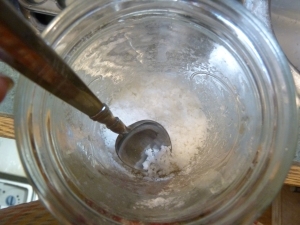I can ferment sauerkraut with my eyes closed, but I have had a hard time with fermented pickles in the past (didn’t turn out well) … I just keep trying. Instead of using whole pickling cucumbers I decided to try my luck and go about it differently, so I sliced the cucumbers this time.
I did not plant cucumbers this year. I talked to my neighbor/friend about growing cucumbers this season because I grow most of my peppers and the zucchini in their garden and he agreed that this year we could share the cucumbers too. He has been growing Armenian cucumbers (actually in the melon family) for the past few years and he always has way more then he needs. The Armenian cukes are nice, but I want to grown pickling cucumbers again.
Back to my experiment… I sliced the cucumbers and put them in a glass gallon jar. I added the herbs and spices that I wanted (dill seed, celery seed, and garlic) and poured the brine over the top. The brine was 1 1/2 T to 4 cups water.
The big thing with fermenting is that you need to keep the vegetable below the liquid to avoid bad bacteria from growing. I could not find a jar that was big enough, yet small enough to fit down through the opening of the gallon jar. I had to resort to using a gallon zip-top bag with a little water in it, then I sunk a pint jar into the bag and filled the jar with some water also. I am not a big fan of plastic, but it worked. I will be either looking for the perfect jar to weigh things down or a different glass jar. As I type this and thing about it – I really could have used my fermenting crock.
The past issues that I had when fermenting pickles in the fermenting crock that I have is the weights. The whole cucumbers are so buoyant and the ceramic weights are a bit on the smaller side that the cucumbers can sneak up on the edges. Then they are exposed to air and things go quite wrong in a hurry.
It worked! I have successfully fermented cucumber slices (three times now!) Boy are they good! We now have a ton of them in the refrigerator and we are munching our way through them fast. I have shared several quarts with our neighbor/friend.
Next year I look forward to canning some pickles so we can enjoy them throughout the winter too, but in the mean time we are enjoying these fermented ones. I know they have more benefits to them (chuck full of healing probiotics!) I also look forward to the fall and winter garden to ferment some of the root veggies like carrots, turnips and onions.
Other post on fermenting:
Anyone else out there fermenting things?
Sincerely, Emily





















